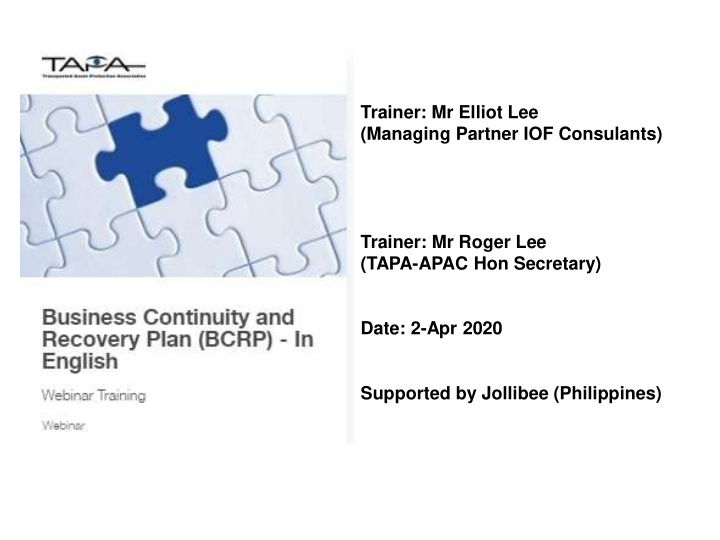



Trainer: Mr Elliot Lee (Managing Partner IOF Consulants) Trainer: Mr Roger Lee (TAPA-APAC Hon Secretary) Date: 2-Apr 2020 Supported by Jollibee (Philippines)
Supply Chain Resilience Framework Business Continuity Management in Supply Chain Module: Business Continuity Management
What is Supply Chain Resilience?
Goal of a BIA is to establish Recovery Time Objectives (RTOs) Here are five critical questions you should ask when performing a BIA: 1.Which departments/processes within the company are most critical? 2.What is the priority to resume operational processes listed in #1? 3.Following a major disruption to operations, how soon must time-sensitive production 4. resume to avoid significant adverse impacts on the company and its customers? 5.What resources are needed to support time-critical operations and minimize potential business interruption? 6.What are the operational and financial impacts of extended down-time?
Perform Risk Analysis/Capabilities Survey ➢ First, look at the types of hazards your company might face .... Floods, fires, severe weather, computer virus attacks, sabotage, pandemic? ➢ What are the likely results of those kinds of events? ➢ Power outages? ➢ Computer failures? ➢ Radio or telephone systems failures? ➢ Personnel who can’t reach key facilities? 7
Identify Critical Business Functions ➢ This is the hardest part of the process. Not every business service you provide will be needed in certain emergencies. Your critical functions become the core of the plan. What you do from here on will support those critical functions….. ➢ Critical functions are the nuts and bolts of the BCP Plan ➢ They form the basis for determining resource requirements: ➢ Staff ➢ Vital information/critical systems ➢ Equipment ➢ Supplies and services ➢ Facilities 8
Activity Details Activity Lists What is a Off-site Materials Team Members Business Requirements Strategy Overviews Continuity Plan? Your Organization Business Continuity Plan 9
What is a Business Continuity Plan? ➢ At a high level, a Business Continuity Plan is a combination of: ➢ defined strategies and detailed procedures for system recovery ➢ defined strategies and detailed procedures for business resumption ➢ a formal team structure for executing the applicable procedures and managing the crisis ➢ all advance arrangements required to support the above 10
What is a Business Continuity Plan? ➢ At a detailed level, a Business Continuity Plan is: ➢ a documented series of activities (Business Resumption Plan) that may need to be performed by designated teams to recover systems and/or resume critical business functions following a disruptive incident 11
What should the detailed plans contain? ➢ Each Team’s plan should contain: Activity Details ❑ Strategy overview for each incident type Activity Lists (or ‘disaster scenario’) Off-site Materials ❑ List of minimum recovery requirements Team Members Recovery Requirements ❑ Team membership and contact info. Strategy Overviews ❑ Off-site materials list and other Your Organization supporting documentation Business ❑ Activity lists (organized by phase Continuity and scenario) Plan ❑ Activity details 12
What is an Activity? ➢ An activity is the ‘Operating Unit’ of the plan ➢ Each activity describes: ➢ Where it can be performed ➢ What has to be done from ➢ How it can be done ➢ When it can start ➢ Who can do it ➢ How long it should last ➢ What is needed to do it ➢ When it should end ➢ Each activity represents a logical, self-contained unit of work that may need to be performed by a single team for a given scenario 13
What is a Phase? A phase is a grouping of Each phase represents a activities used to provide a critical stage in the logical structure for each Operations Resumption plan team’s plan There are typically five phases 14
Phase 1 – Initial Response & Assessment Take any immediate actions Assess the impact of the event warranted by the event on operations 1. Initial Response & Assessment 15
Phase 2 – Interim Contingency Measures Implement short term Such as transferring work to measures to limit the impact staff at another location, or of the event having key staff work from home 2. Interim Contingency Measures 1. Initial Response & Assessment 16
Phase 3 – Resource Provisioning Such as desks, phones, PC’s, Provide the minimum resources needed to resume printers, servers, system operations at an alternate connectivity, electronic data, location etc. 3. Resource Provisioning 2. Interim Contingency Measures 1. Initial Response & Assessment 17
Phase 4 – Operations Resumption Resume an acceptable level May require relocation of of operations at the staff, recreation of lost data, alternate location processing of backlog, etc. 4. Operations Resumption 3. Resource Provisioning 2. Interim Contingency Measures 1. Initial Response & Assessment 18
Phase 5 – Return to Normal Complete all actions Transfer staff back to original required to resolve the location and resume normal 5. Return event operations To Normal 4. Operations Resumption 3. Resource Provisioning 2. Interim Contingency Measures 1. Initial Response & Assessment 19
Phases of an Operations Resumption Plan 5. Return To Normal Note: Depending upon the nature and duration of the event, some or all of the departments may be able to return to normal without executing phase 3 & 4 2. Interim Contingency Measures 1. Initial Response & Assessment 20
Plans and Procedures BCP plans must: ➢ Be effective with and without warning. ➢ Take an all-hazard approach. ➢ Include alternate facilities. ➢ Have critical business functions operational within an acceptable amount of time. ➢ Be able to sustain operations for an extended timeframe. Plans and Procedures 21
Recommend
More recommend